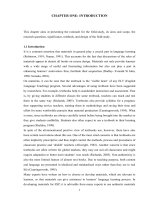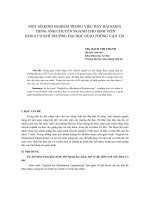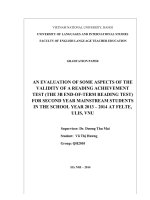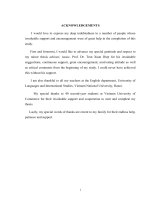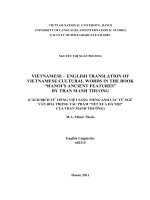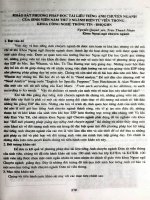Xây dựng các bài tập đọc bổ trợ tiếng anh chuyên ngành cho sinh viên năm thứ hai tại khoa điều dưỡng trường cao đẳng y tế phú thọ
Bạn đang xem bản rút gọn của tài liệu. Xem và tải ngay bản đầy đủ của tài liệu tại đây (557.48 KB, 61 trang )
VIETNAM NATIONAL UNIVERSITY, HANOI
UNIVERSITY OF LANGUAGES AND INTERNATIONAL STUDIES
FACULTY OF POST-GRADUATE STUDIES
PHAN THỊ THU HÀ
DEVELOPING ESP SUPPLEMENTARY READING EXERCISES
FOR SECOND-YEAR STUDENTS AT FACULTY OF NURSING,
PHU THO MEDICAL COLLEGE
XÂY DỰNG CÁC BÀI TẬP ĐỌC BỔ TRỢ TIẾNG ANH CHUYÊN NGÀNH
CHO SINH VIÊN NĂM THỨ HAI TẠI KHOA ĐIỀU DƯỠNG,
TRƯỜNG CAO ĐẲNG Y TẾ PHÚ THỌ
MINOR PROGRAM THESIS
Field: English Teaching Methodology
Code: 601410
HANOI, 09-2012
VIETNAM NATIONAL UNIVERSITY, HANOI
UNIVERSITY OF LANGUAGES AND INTERNATIONAL STUDIES
FACULTY OF POST-GRADUATE STUDIES
PHAN THỊ THU HÀ
DEVELOPING ESP SUPPLEMENTARY READING EXERCISES
FOR SECOND-YEAR STUDENTS AT FACULTY OF NURSING,
PHU THO MEDICAL COLLEGE
XÂY DỰNG CÁC BÀI TẬP ĐỌC BỔ TRỢ TIẾNG ANH CHUYÊN NGÀNH
CHO SINH VIÊN NĂM THỨ HAI TẠI KHOA ĐIỀU DƯỠNG,
TRƯỜNG CAO ĐẲNG Y TẾ PHÚ THỌ
MINOR PROGRAM THESIS
Field: English Teaching Methodology
Code: 601410
Supervisor: Dr. Dương Thị Nụ
HANOI, 09-2012
LIST OF ABBREVIATIONS
- ESP: English for Specific Purposes
- PTMC: Phu Tho Medical College
- EMP: English for Medical Purposes
- L2: Second Language
- U.S: United States
- U.K: United Kingdom
- EFL: English as a Foreign Language
- T: Teachers
- S: Students
- N: number of the teachers/ students
- P: percentage of the teachers/ students
LIST OF TABLES
Table 1: Exercises believed to be suitable to develop ESP reading skills (Grellet,
1981: 4-5).
Table 2: Exercise types in ESP reading skills (Kenedy and Bolitho, 1991: 74-84).
Table 3: Types of reading exercises in each unit in the currently used teaching
coursebook.
Table 4: Teachers and students’ perception of students’ difficulties in terms of
reading exercises.
Table 5: Teachers and students’ perceptions of the effectiveness of using
supplementary exercises in reading lessons.
Table 6: Teachers and students’ perceptions of exercise types to be included in the
ESP supplementary reading exercises.
Table 7: The proposed supplementary reading exercises.
LIST OF FIGURES
Figure 1: Teachers and students’ perceptions of the reading exercises in the
currently used teaching coursebook.
Figure 2: Teachers and students’ perceptions of the necessity of ESP supplementary
reading exercises.
Figure 3: Teachers and students’ perceptions of exercise types accompanying the
reading texts in the currently used teaching coursebook.
Figure 4: The frequency of the teachers and students in using supplementary
reading exercises.
Figure 5: Teachers and students’ perceptions of the place of using supplementary
reading exercises.
TABLE OF CONTENTS
Page
DECLARATION ................................................................................................ i
ACKNOWLEDGEMENTS ………………………………………………….... ii
ASTRACT …………………………………………………………………...... iii
LIST OF ABBREVIATIONS …………………………………………............
iv
LIST OF TABLES ………………………………………………………….....
v
LIST OF FIGURES ………………………………………………………….... vi
PART A: INTRODUCTION
1. Rationale of the study ……………………………………………………..... 1
2. Objectives of the study……………………………………………………....
2
3. Research questions………………………………………………………......
2
4. Scope of the study………………………………………………………….... 2
5. Research Methodology…………………………………………………….... 2
6. Significance of the study …………………………………………………....
3
7. Design of the study………………………………………………………...... 3
PART B : DEVELOPMENT
CHAPTER 1: THEORETICAL BACKGROUND
1.1. An overview of English for Specific Purposes (ESP) and English for
Medical Purposes (EMP) ………………………………………………….....
4
1.1.1. ESP ……………………………………………………………………...
4
1.1.2. EMP …………………………………………………………………...... 6
1.2. An overview of materials development in language teaching ................ 7
1.2.1. Materials and materials development………………………………........ 7
1.2.1.1. Definition of materials……………………………………………….... 7
1.2.1.2. Materials development …………………………………………..........
7
1.2.2. Materials evaluation and its criteria …………………………………...
7
1.2.3. Supplementary materials ………………………………………………..
9
1.3. An overview of reading comprehension in teaching ESP .....................
9
1.3.1. Definitions of reading and reading comprehension……………………..
9
1.3.1.1. What is reading?....................................................................................
9
1.3.1.2. What is reading comprehension?...........................................................
10
1.3.2. Types of ESP reading exercises……………...………………………….. 11
1.4. Summary ....................................................................................................
13
CHAPTER 2: THE STUDY
2.1. Settings ........................................................................................................ 14
2.2. The study.....................................................................................................
15
2.2.1. The subjects...............................................................................................
15
2.2.2. Instruments for collecting the data ...........................................................
15
2.2.3. Data collection procedures .......................................................................
16
2.2.4. Data analysis and major findings .............................................................. 17
2.2.4.1. An overview of the currently used teaching textbook ........................... 17
2.2.4.2. Class observation ................................................................................... 19
2.2.4.3. Data from survey questionnaires ...........................................................
20
2.2.4.4. Major findings .......................................................................................
31
2.3. Summary ...................................................................................................
33
CHAPTER 3: RECOMMENDATIONS
3.1. Suggested exercises for the ESP supplementary reading ......................
34
3.2. Guidance for the teachers and students ................................................
36
3.2.1. Guidance for the teachers.........................................................................
36
3.2.2. Guidance for the students.........................................................................
37
3.3. Summary ...................................................................................................
37
PART C: CONCLUSION
Recapitulation ...................................................................................................
38
Conclusions ........................................................................................................ 38
Limitations of the study ...................................................................................
39
Suggestions for further study ..........................................................................
40
REFERENCES .................................................................................................
I
APPENDICES ................................................................................................... III
APPENDIX 1 ..................................................................................................... III
APPENDIX 2 ..................................................................................................... VI
APPENDIX 3 ..................................................................................................... X
PART A: INTRODUCTION
1. Rationale of the study
It is undeniable that English now is one of the most commonly used
languages throughout the world. In Vietnam, with the changes and the development
of the economy and society, as well as the implementation of the open-door policy,
English has been used more and more widely. Importantly, it has influenced on our
education curriculum as a compulsory subject. In recent years, there has been a
global increase in the number of language teachers who are required to teach
English to students from various fields such as engineering, information science,
medicine, accounting, etc to enable them to cope with their academic work. This
type of English is called English for Specific Purpose (ESP). Since ESP was
introduced, it has attracted the attention of many language instructors. Furthermore,
the idea of ESP has been welcomed by staffs of universities who have seen the great
benefits of learning ESP. In addition, it is to meet the learners’ needs for better
reading of specialized books in English and for more successful job performance in
the future.
The English language program at Phu Tho Medical College (PTMC) is
designed to be composed of two major stages. The first stage is called English for
General Purposes, focusing on developing students’ ability to communicate in
English at a very simple level. The second stage is ESP, emphasizing the
development of students’ linguistic skills that are linked to their future occupational
purposes. After having taught English at PTMC for 3 years, the researcher finds that
although the currently used teaching coursebook for ESP has shown a great deal of
improvement, it still has some problems with reading exercises. Some are too easy
for students whereas some make students bored. Therefore, it does not help students
improve their reading skill much. In this case, the main task for the teachers is
developing teaching materials to improve students’ reading skill. In order to do this,
the teachers need to evaluate every unit to see what the problems are and then, try to
think of the ways to improve them. There are many things that the teachers can do
to improve the units. They can be looking for supplementary materials from
different sources, changing the procedures of teaching, designing activities to
motivate the students, etc. One of the effective ways is developing supplementary
materials. The above mentioned reasons lead me to my choice of the study:
Developing ESP Supplementary Reading Exercises for second-year students at
Faculty of Nursing, Phu Tho Medical College.
2. Objectives of the study
The study aims to:
- develop a theoretical framework which is appropriate for the development of ESP
supplementary reading exercises for second-year students of nursing, PTMC.
- investigate and analyze the needs of ESP students of nursing and ESP teachers,
PTMC to serve as a practical base for developing ESP supplementary reading
exercises.
- propose ESP supplementary reading exercises for second-year students at Faculty
of Nursing, PTMC, which can meet both teachers and students’ needs.
3. Research questions
On carrying out the research, the following research questions are to be
answered:
- What are the reading needs of the nursing students at PTMC?
- Which reading exercises should be supplemented for second-year students at
Faculty of Nursing, PTMC?
4. Scope of the study
As the current coursebook is compulsory, this study is intended to focus on
supplement only. In the scope of this study, only ESP supplementary reading
exercises, which are suitable for the local situation of PTMC, are proposed.
Moreover, they are intended for only the second-year students of nursing.
5. Research Methodology
The study is based on a survey research, which involves a combination of
quantitative and qualitative methods to obtain its objectives. To begin with, an
extensive of theoretical background is conducted, defining the notions of ESP in
general and medical English in particular, some important aspects of materials
development in language teaching and reading comprehension in teaching ESP.
Then, the major methods used in the study are the quantitative and qualitative
methods. To collect data, survey questionnaires to the second-year students of
nursing and ESP teachers are in favour. The results from the survey questionnaires
are combined with coursebook evaluation, class observation to propose ESP
supplementary reading exercises for the second-year students at Faculty of Nursing,
PTMC, which can meet both teachers and students’ needs.
6. Significance of the study
Due to the lack of ESP supplementary reading exercises that are suitable for
the local situation, this study is hoped to provide useful and interesting exercises
based on reading texts in the currently used teaching coursebook for the secondyear students at Faculty of Nursing, PTMC.
Hopefully, the supplementary reading exercises will be developed into
supplementary materials and will be used as the basis to construct other
supplementary reading exercises.
7. Design of the study
This study consists of three parts:
Part A: Introduction: presents the rationale, objectives, research questions, scope,
methodology, significance, and the design of the study.
Part B: Development: constitutes the body of the study. It consists of three chapters:
- Chapter 1: Theoretical background
- Chapter 2: The study
- Chapter 3: Recommendations
Part C: Conclusion: concludes recapitulation, conclusions, limitations of the study
and suggestions for further study.
PART B: DEVELOPMENT
CHAPTER 1: THEORETICAL BACKGROUND
This chapter presents a theoretical background for the study. It is presented
in three sections. The first section discusses English for Specific Purposes (ESP) in
general and English for Medical Purposes (EMP) in particular. The second section
looks at materials development in language teaching. The last section discusses
reading comprehension in teaching ESP.
1.1. An overview of ESP and EMP
1.1.1. ESP
“ESP” stands for English for Specific Purposes. Different authors have
defined this term in different ways. According to Hutchinson and Waters (1987:
19), ESP is “an approach to language teaching in which all decisions as to content
and method are based on the learners’ reason for learning”. For Hutchinson and
Waters, the starting point in determining appropriate input for ESP course is
identifying learners’ needs.
Likewise, Strevens (1988) defined ESP by identifying its absolute and
variable characteristics. His definition of ESP makes a distinction between four
absolute and two variable characteristics:
4 absolute characteristics:
ESP consists of English language teaching which is:
- designed to meet specified needs of the learner;
- related in content (that is in its themes and topics) to particular disciplines,
occupations and activities;
- centred on the language appropriate to those activities in syntax, lexis, discourse,
semantics and so on, and analysis of this discourse;
- in contrast with “General English”.
2 variable characteristics:
ESP may be, but is not necessarily:
- restricted as to the language skills to be learned (for example reading only);
- not taught according to any pre-ordained methodology
Ten years later, theorists Dudley-Evans and St John (1998) modified
Strevens’ original definition of ESP to give an extended definition as follows:
Absolute characteristics:
- ESP is designed to meet specific needs of the learner;
- ESP makes use of the underlying methodology and activities of the discipline it
serves;
- ESP is centred on the language (grammar, lexis, register), skills, discourse and
genres appropriate to these activities.
Variable characteristics
- ESP may be related to or designed for specific disciplines;
- ESP may use, in specific teaching situations, a different methodology from that of
general English;
- ESP is likely to be designed for adult learners, either at a tertiary level institution
or in a professional work situation. It could, however, be for learners at secondary
school level;
- ESP is generally designed for intermediate or advanced students. Most ESP
courses assume some basic knowledge of the language system, but it can be used
with beginners.
Clearly, the definition of Dudley-Evans and St. John was influenced by that
of Strevens (1988) although they improved it substantially by removing the absolute
characteristic that “ESP is in contrast with General English” and revised and
increased a number of variable characteristics. They asserted that ESP can be but is
not necessarily related to a specific discipline, nor does it have to be aimed at a
certain age group or ability range. Furthermore, ESP is likely to be used with adult
learners although it could be used with young adults in a secondary school setting.
It is obvious that although the above definitions stem at different periods of
time by different authors, all of them reveal that ESP should be seen simply as an
“approach” to teaching, or what Dudley-Evans (1998) described as an “attitude of
mind” and any ESP course must be based on learners’ needs.
1.1.2. EMP
It can be noticed that the attention to learners’ needs is a key element in any
above definitions of ESP. So, EMP is intended to help the medical students who are
planning to study medicine in English. The term “English for Medical Purposes”
refers to “the teaching of English for doctors, nurses, and other personnel in the
medical professions.” It involves the teaching/ learning of English for a utilitarian
purpose, an identifiable goal - typically, the successful performance of work or the
optimum effectiveness of medical training. In general terms, EMP (a) is designed to
meet the specific English language needs of the medical learners (e.g. nurses,
dentists, etc.); (b) focuses on themes and topics specific to the medical field; (c)
focuses on a restricted range of skills which may be required by the medical
learners (e.g. for writing a medical paper, preparing a talk for medical meeting, etc).
EMP can be considered as a sub-branch of ESP. What distinguishes EMP
from other ESP sub-branches is that EMP has its own set of medical discourse.
Gylys and Wedding (1983) argued that medical discourse is a particular
terminology employed to effectively and accurately achieve a communicative
purpose in health care settings such as diagnosis. According to Yang (2005), EMP
terminology mostly consists of prefixes and affixes, which should be carefully
noted when designing an EMP course.
Moreover, medical language can be the language employed by the doctors
and the nurses in writing medical records and communicating with each other. In
fact, medical students and nursing students have various reasons for learning
medical English. The doctors need to learn to read and write medical terminology in
L2 to complete hospital admission notes, diagnosis, and orders, which, later on, the
nurses must read, follow in order to carry out nursing interventions and take care of
their patients. For these medical and nursing professionals, their first step to access
medical language is to learn medical words. Besides, they also need to read journals
and books in medical genres to speak to colleagues on professional visits, to make
use of the expanding and increasingly important database available through the
internet, to participate in international conferences, to write up research for journal
publication, etc.
1.2. An overview of materials development in language teaching
1.2.1. Materials and materials development
1.2.1.1. Definition of materials
Tomlinson (1998) had the idea that materials can be anything that is
deliberately used to increase the learner’s knowledge and/ or experience of the
language. Therefore, materials can be cassettes, video, CD-rooms, dictionaries,
grammar books, newspapers, food packages, photographs, even pencils, chairs or a
bad (realia), etc. However, the focus here is the text materials. Such materials
include those that have been either specifically designed for language learning and
teaching (textbooks, worksheets, computer software); authentic materials (off-air
recordings, newspaper articles) that have been specially selected and exploited for
teaching purposes by the classroom teacher; teacher-written materials and learnersgenerated materials.
1.2.1.2. Materials development
According to Tomlinson (1998: 2), “Materials development refers to
anything which is done by writers, teachers or learners to provide sources of
language input and to exploit those sources in ways which maximize the likelihood
of intake: in other words the supplying of information about and/ or experience of
the language in ways designed to promote language learning”.
Materials developers may do many things as writing textbooks, telling
stories, bringing advertisements into the classroom, etc., whatever they do to
provide input in principled ways related to what they know about how the language
can be effectively learned.
1.2.2. Materials evaluation and its criteria
It is believed that evaluation of materials is a crucial task for language
teachers. That means besides the job of teaching, EFL teachers need the ability to
evaluate teaching materials effectively.
Materials evaluation is defined differently by different authors. Brown
(1995: 218) states “Evaluation is the systematic collection and analysis of all
relevant information necessary to promote the improvement of a curriculum, and
assess its effectiveness and efficiency, as well as the participants’ attitudes
within the context of the particular institutions involved”.
Materials evaluation is based on different criteria. Cunningsworth (1984: 56) set out the following four principles of evaluation which have been applied by
many teachers and students in a great variety of teaching and learning contexts.
- Relate the teaching materials to your aims and objectives.
- Be aware of what language is for and select teaching materials, which help equip
your students to use language effectively for their own purposes.
- Keep your students’ learning needs in mind.
- Consider the relationship between language, the learning process and the learner.
However, the main concern of the study is reading materials; therefore, a
checklist for evaluation of reading texts will be specifically given as follows:
- Offer exercises for understanding of plain sense and implied meaning.
- Relate reading passages to the learners’ background.
- Select passages within the vocabulary range of the pupils.
- Select passages reflecting a variety of styles of contemporary English.
(Williams, 1983)
In short, the teacher should take over where the coursebook leaves off, and
he or she must be able to assess its strengths and weaknesses. It is necessary for
EFL teachers to be acquainted with the principles of coursebook evaluation. They
can be given practice in analyzing coursebooks in order to find out whether the
organization of materials is consistent with the objectives of the curriculum. When
teachers examine the selection of items of speech, grammar, or vocabulary in a
coursebook, they are improving their competence in the language and at the same
time sharpening their teaching skills.
1.2.3. Supplementary materials
“Supplementary materials” is one of the basic terms in a glossary proposed
by Tomlinson (1998) in materials development in language teaching. In his
opinion, supplementary materials are defined as “materials designed to be used in
addition to the core materials of a course. They are usually related to the
development of skills of reading, writing, listening or speaking rather than to the
learning of language items”. (Tomlinson, 1998: xiii)
Actually, most language-teaching coursebooks probably need supplementing
to some extent, if only in order to tailor them to the needs of a particular class or to
offer richer options. According to Ur (1991), there are “package” of supplementary
materials such as computers, simplified readers, overhead projectors, posters,
pictures, or games. Each type, obviously, has certain contribution to language
teaching and its own good points as well as drawbacks.
1.3. An overview of reading comprehension in teaching ESP
1.3.1. Definitions of reading and reading comprehension
1.3.1.1. What is reading?
Reading is a completely individual activity that takes place in all different
ways from newspapers, magazines, written texts, telephone directory, labels on
medicine bottles, notices, etc. The ability to read is such a natural part of human
beings that they seldom try to define reading. However, there are still different
points of view on the definition of reading.
Goodman (1971: 135) terms reading as “a psycholinguistic process by which
the reader, a language user, reconstructs, as best as he can, a message which has
been decoded by a writer as a graphic display”. He views this act of reconstruction
as “a cyclical process of sampling, predicting, testing and conforming”. According
to this point of view, efficient readers develop predictions about the content of a
passage. Along with textual clues, knowledge and experience help the readers
develop expectations about what they will read. The efficient reader then reads
rapidly to confirm or refute these predictions. If hypotheses are confirmed, the
reader continues with an increasing store of information on the topic. If they are not
confirmed, the reader returns and rereads more carefully.
Taking the same view, Nuttal (1982: 4) asserted that reading involves the
recognition of written words “to get meaning from a text”. Rejecting the views in
which reading is regarded as a rather passive and receptive skill she says, “The
meaning is not lying in the text waiting to be passively absorbed. On the contrary,
the reader is actively involved and often has to work to get the meaning out”.
One conclusion drawn from the definition of reading above is that reading is
not simple nor is it a single skill. It is a complex process involving an active search
for information and interaction with the text; it requires the constant constructive
involvement of the reader in what he is doing; and it demands the use of higher
mental abilities. The mental activities used for constructing meaning from the text
are generally referred to reading strategies or reading skills.
1.3.1.2. What is reading comprehension?
In many parts of the world, reading has traditionally been the skill that is the
most emphasized in foreign language teaching and learning. Today this is still true
despite the current emphasis on other skills like speaking and listening. So what is
reading comprehension? In fact, there have been numerous attempts to define it, and
each of the definitions reflects what reading is to the scholar presenting that view.
Grellet (1981: 3) states: “reading comprehension or understanding a written
text means extracting the required information from it as effectively as possible”. In
this sense, reading comprehension simply means reading and understanding. It
should be noted that reading comprehension is composed of two equally important
components. Decoding - the ability to translate text into speech - is only part of the
process reading comprehension. The other part is language comprehension- the
ability to understand spoken language. The readers, as they read, receive
information from the writer via words, sentences and paragraphs and so on, and
make an attempt to understand his/ her feelings.
According to Harris and Hodges (1995: 39), “reading comprehension is the
construction of the meaning of a written communication through a reciprocal,
holistic interchange of ideas between the interpreter and the message”. In this case,
reading comprehension requires an action on the part of the reader. That action
involves the use of the existing knowledge that the reader has on the topic of the
text as well as the text itself in order to create meaning.
From the ideas above, it can be concluded that there is no consensus of what
reading comprehension is as each writer comprehends and gives its different
definitions through his own point of view. However, they share some certain
characteristics. Reading comprehension not only includes linguistic recognition and
cognitive understanding but also tends to be affected the reader’s appreciation.
When reading, readers need to understand, analyze, and response to what is written
in order to comprehend the content of the text and apply it in their own life as
effectively as possible.
1.3.2. Types of ESP reading exercises
Grellet (1981) stated that there are a number of exercise types focusing on
the normal organization and the contents of the text to develop reading skill. They
are classified into four main types named: reading techniques, the form analysis of
the text, the understanding of the meaning in the text, and the assessment of the text.
Among various exercises proposed by Grellet (1981: 4-5), those listed in the
following table are believed to be used more often in ESP reading.
Reading
Form analysis of Understanding of the Assessment of
techniques
the text
meaning in the text
the text
1. Inference using
1. Chronological
1. Ordering sequences
1. Deciding fact
contextual clues,
sequence
of pictures
or opinion
or word formation
2. Analogy and
2. Comparing texts
2. Finding
2. Linking
contrast
and pictures
writer’s
sentences and
3. Classification
3. Matching
intention
ideas using
4. Completing a
reference, link
document (a table,
words
charts)
3. Predicting
5. Reordering events
4. Anticipation
using tables
5. Skimming
6. Comparing several
6. Scanning
texts: note-taking
7. Inference using
7. Question-types:
- Multiple choices
- True/ False
- Completing a
summary
- Completing
sentences
8. Finding errors
Table 1: Exercises believed to be suitable to develop ESP reading skills
(Grellet, 1981: 4-5)
Kenedy and Bolitho (1991: 74-84) also suggested several types of exercises
which can be used to train self-studying strategies towards reading ESP materials in
the following table:
1. Reference skills
5. Relating diagrams to text
2. Skimming
6. Predicting and sequencing the structure of a text
3. Scanning
7. Understanding elliptical writing-telexes
4. Relating graphs to texts
8. Reading instructions and notices (survival reading)
Table 2: Exercise types in ESP reading skills
(Kenedy & Bolitho, 1991: 74-84)
The above exercise types are viewed as a guide for ESP reading materials
designers to make their materials varied, technically distinguishing and appropriate
to the teaching and learning of ESP.
1.4. Summary
This chapter provides a theoretical background related to all essential aspects
for developing ESP supplementary reading exercises which is the goal of this study.
The researcher hopes that in the light of this background, appropriate ESP
supplementary reading exercises would be developed.
CHAPTER 2: THE STUDY
This chapter deals with the settings of the study. Then, the subjects of the
study, instruments for collecting the data and data collection procedures are
presented. Finally, data are analysed and major findings are concluded.
2.1. Settings
ESP has been recently introduced in the training curriculum at PTMC as
recognition of the increasing importance of the language as a tool that helps the
students to access information and medical advancements of the world. One of the
programs offered by the college is to develop the nursing students having the skill
in accessing, analyzing and critically evaluating the information available for their
career purposes. Reading comprehension is therefore considered a vital linguistic
skill that every student must master if he/ she wishes to advance further in his/ her
future career.
In 2009, under the college’s decision to develop the students’ ability of using
English effectively for their academic study and future profession, an ESP course of
reading comprehension was designed for both academic and professional purpose.
However, the reading exercises in the coursebook have revealed some major
drawbacks, one of which is ignorance of the students’ varied needs in different
specific disciplines. Therefore, it is clear that the reading exercises have to be
revised or even redeveloped to be more relevant and appropriate for ESP students of
nursing.
The college now has eleven English teachers aged between 26 and 36. Apart
from one teacher who is studying Ph.D degree in Germany, none of them has ever
been abroad to study and they do not have chances to communicate with English
native speakers frequently. However, all of English teachers at PTMC are young. In
general, most of them are well qualified in terms of their proficiency in English and
knowledge.
ESP students of nursing at PTMC are those who have completed ESP course
offered by the college as defined in the curriculum. They come from various areas
in Viet Nam. By that, the researcher means their background is varied in terms of
their previous educational environment, socio-economic status. For those students,
learning ESP is supposed to be beneficial from the basic knowledge of GE learning.
At the same time, the students who have been exposed to good English instruction
at their secondary school can suffer from the drag of no further language teaching in
class. So, their level of proficiency may be deterred affecting their motivation in
learning ESP. The mixed ability of the students in term of their English proficiency
is obviously an obstacle to the effort.
2.2. The study
2.2.1. The subjects
The subjects of the study w er e t h e second-year students of Faculty of
Nursing taking ESP subject in the academic year of 2011-2012, PTMC. The study
was conducted 150 students from three randomly chosen classes, who took English
for Medical Purposes class related for their own field. Students’ age ranged from 19
to 21 years with an average age 19.5. Most of them have been learning English for 7
years. The students of nursing get an ESP course for 1 semester (30 hours).
Besides, the subjects of the study were also 6 ESP teachers. They are all
young teachers. The oldest teacher has been teaching English for 12 years and the
youngest teacher has been teaching English for 4 years. All of them have been
teaching ESP for 3 years.
2.2.2. Instruments for collecting the data
Hutchinson and Waters (1987: 59) suggested that there are a large number of
ways in which information can be gathered about target needs such as interview,
observation, questionnaires, etc. Since any source of information is likely to be
incomplete or partial, a triangular approach (i.e. collecting information from two or
more sources) should be advisable. Thus, information in this study is collected from
a wide variety of sources: coursebook evaluation, class observation and the
questionnaires.
Questionnaires were used as one of the main tools to collect the data in my
study. Survey questionnaire was chosen as a quantitative approach because there are
a large number of students whom the researcher would like to get information from.
Survey questionnaire with its advantage of collecting data with a large number of
participants in a short period is highly suitable for my study.
In order to have the data for my study, two survey questionnaires were
designed, one for the students and one for the teachers. Both of them consisted of 8
questions pertaining: a) Difficulties in terms of reading skill, b) Opinions on
developing ESP supplementary reading exercises for the second-year students, c)
Exercises types to be included in the ESP supplementary reading exercises. They
were chosen as a method employing the quantitative approach. The questionnaires
were not distributed to respondents to complete on their own but with the
researcher’s presence so that clarification and disambiguation could be made timely.
The questionnaires were designed to investigate the needs of ESP students of
nursing and ESP teachers, PTMC to serve a practical base for developing ESP
supplementary reading exercises.
2.2.3. Data collection procedures
The data were collected from June 15th, 2012. The questionnaire for the
teachers was given to 6 teachers of English on the Faculty’s weekly meeting. The
researcher was always ready to answer any questions raised by the teachers. After
the teachers freely completed the questionnaire, they were returned to the researcher
immediately.
Unlike the case of the teachers, steps to conduct the survey questionnaire for
the students were as follows: First, the purpose of the questionnaire was stated so
that all participants understood what they were going to join in. Second, the subjects
were required to read the instructions and asked for clarification where the meaning
was not clear enough. Third, one hundred and fifty – page questionnaires were
administered to 150 nursing students. The subjects worked independently on their
papers and gave their opinions freely about issues raised in the questionnaire. No
discussions or verbal exchanges were made except for personal explanations about
some points unclear between an individual participant and the researcher. Finally,
when completing the questionnaires, the students handed over the completed
questionnaires to the researcher.
As mentioned above, the data for this study were gathered from three
sources: documentary analysis, class observation and survey questionnaire. So, it
requires both analytical and statistical analysis.
2.2.4. Data analysis and major findings
2.2.4.1. An overview of the currently used teaching coursebook
The ESP material for nursing was designed by a group of teachers of English
at PTMC. There are six units in the coursebook organized around the reading skill.
Each unit is taught in five forty-five-minute class hours. Students have 30 periods to
learn the texts in the coursebook. All the texts are about medical topics providing
the students with general knowledge about some important systems in the human
body.
The titles of six units in this coursebook are as follows:
Unit 1: Human anatomy – parts of the body
Unit 2: The respiratory system
Unit 3: The cardiovascular system
Unit 4: The digestive system
Unit 5: The skeletal – muscular system
Unit 6: The nervous system
The objectives of all the lessons are the same. They are: to know and use
some anatomical vocabularies on human body/ the respiratory system/ the
cardiovascular system/ the digestive system/ the skeletal – muscular system/ the
nervous system and to understand and translate the reading texts into Vietnamese. It
can be seen that the objectives of the lesson reveal problems. They do not aim to
help students acquire an accurate understanding of what it means to read in English.


